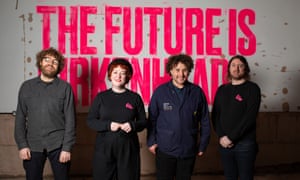‘Community, not profit’: the creative renaissance of Birkenhead
Across the Mersey from Liverpool, a group of grassroots promoters is trying to avoid that city’s redevelopment errors as they champion a vibrant cultural renewal

Emblazoned above Christopher Torpey, co-founder of music venue Future Yard, are the words “The future is Birkenhead” in pink capital letters. “It’s tongue in cheek, but we mean what we say,” he says. “This town was once grand and prosperous, and it needn’t be forgotten about and viewed as a pauper to Liverpool. We wanted to have a venue, but also make people think differently about Birkenhead.”
Birkenhead is barely a mile from Liverpool, situated on the opposite bank of the River Mersey. It was once known as the “New York of Europe” thanks to its shipbuilding, but deindustrialisation and waves of austerity have created significant decline. Now, however, a growing cluster of organisations known informally as the Leftbank Collective hope to provide the infrastructure for a resurgent creative community. Recent projects such as an immersive audio experience by US avant-garde musician Kali Malone in a 153-year-old hydraulic tower (commissioned by Abandon Normal Devices), and an interactive walking tour – featuring new pieces by Wirral musicians including Half Man Half Biscuit and OMD, inspired by local landmarks – are celebrating the town’s former grandeur.
Larger council-backed schemes are planned, as is a “container village” plotted by Liverpool businessman Chris Lee. But it’s the grassroots projects that have artists most excited, those “built around community and social equity, not profit” says Matthew Hogarth, a co-founder of both Future Yard and Eggy Records, a label linking some of Merseyside’s most exciting DIY musicians.
Future Yard began as a one-off festival in 2019, and various Liverpudlian attendees told Torpey it was their first time in the town. “It’s like: are you joking me? It’s right here!” But apart from pub shows, Birkenhead has not had a live music venue for generations. “We had to schlep over to Liverpool to play,” says singer-songwriter Bill Ryder-Jones of his time in the Coral, who formed in the Wirral town of Hoylake. “A decent venue over here has been needed for a long time.”
The relationship between Birkenhead and Liverpool is complex, the river as much a psychological barrier as physical. “If you’re from Birkenhead you’d probably feel forgotten about,” Ryder-Jones says. “But at the same time, you can’t be from the Wirral and pretend you don’t gain a huge amount from just being close to Liverpool.”
“There were always pockets of stuff going on in pubs,” says Louisa Roach of the band She Drew the Gun of her teenage years in Birkenhead. “But it didn’t feel like somewhere with opportunities. Liverpool was where all the venues and promoters were. Now Birkenhead is desperate for regeneration. The high street is a ghost town after years of austerity, but there’s a lot of potential and existing beauty to build on. Spaces like Future Yard feel like the start of something good, so I just hope the council has the vision to look after them.”
Future Yard are well aware of the downsides of redevelopment. “We’ve seen it done badly on our doorstep in Liverpool,” says Torpey. The past six years have seen Liverpool venues such as the Kazimier, Sound, the Zanzibar and MelloMello all closed or demolished to make way for flats and student bars, and the city was recently stripped of its Unesco world heritage status thanks to clumsy development projects. “It’s been infuriating, the spaces we’ve lost,” says Roach.
Cultural regeneration, done correctly, is a mission shared across the Leftbank Collective. The Bloom Building is one of them, an old warehouse newly painted in vivid multicolour. As well as a gig venue, bar and workspaces, it houses the Open Door, which provides free talking therapy. Director Lee Pennington says it’s “an arts organisation rather than your standard counselling service”, and much of its outreach is through gigs. “Someone might come along because they love what’s on, and say: what else goes on here?”
Also based in the Bloom Building is Convenience Gallery, previously a stall in Birkenhead market. “On our first day we invited everyone to come in, whether it was artists or people walking past on the day, then began to run all of our programming from that. We wanted local people to shape what the gallery would be,” says co-founder Ryan Gauge. At Future Yard, too, “we want local people to feel that they can have a cup of tea and tell us what they need, and our programming can react,” says Torpey.
Future Yard’s Propellor scheme is also linking young people with experienced music industry mentors to establish long-term careers. “I’ve worked on development programmes in the past and they’ve always ended in three months,” says Future Yard’s Cath Hurley. “Whereas we’ve got this beautiful community of creative people at all times.”
The pandemic threatened to derail this progress. Future Yard had only just announced its first gigs before closing again. A report by Make, which offers cheap space for artists and small businesses, said that 85% of its partners were ineligible for government support, funding that would have totalled £450,000 for its Birkenhead network. Nevertheless, they weathered the storm. Make offered to accept creative skills in lieu of rent; the owners of Convenience Gallery worked second jobs. “Of course, it wasn’t good that our frontline services had to close, but we used that time to make sure we were taking stock,” says Open Door’s Pennington.
“It forced us to sit down and think about what we wanted to do,” says Torpey. “To think about what Future Yard could be to people.” They hope, in time, for the venue itself to be as much of a draw as the bands they book, giving the example of OMD’s Andy McCluskey, who has said he formed the synth-pop band in the late 70s just to play at Liverpool venue Eric’s. “Why can’t we have that aim? Perhaps there’s a group of kids sat somewhere in Birkenhead, thinking: ‘Let’s form a band so we can play Future Yard.’ The most important regeneration we can be involved in is in people’s heads.”
This article was updated on Thursday 5 August to clarify that Kali Malone’s installation was commissioned by Abandon Normal Devices.



